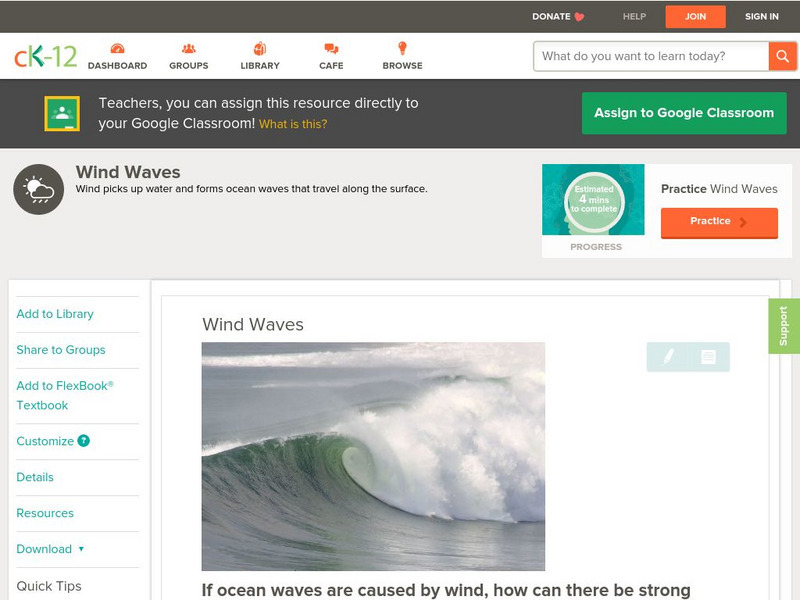Hi, what do you want to do?
Curated OER
Three Methods of Heat Transfer
Students participate in a variety of experiments designed to illustrate types of heat transfer including conduction, convection and radiation. They complete worksheets as an assessment of the experiments.
Curated OER
The Coast is Clear
For this environmental worksheet, students become aware of the animals that inhabit the sea coast by reading a paragraph and coloring the picture. Students learn the importance of keeping beaches clean.
Curated OER
Frozen Film
Students are introduced to the topic of light interference through this hands-on activity. They observe how light reflects off two surfaces and then meets to form an interesting variation of color on a film surface.
Curated OER
Water World
Learners explore the various steps of the water cycle. They identify the three steps in the water cycle and how they are related. Students describe three ways to conserve water. Learners explore the origin of the water source that...
Curated OER
Where's the Beach?
Students use beach profile data to analyze how erosion and sediment transport changed seashore slopes. In this geology activity, students plot the data provided and analyze erosion patterns. They also assess coastal erosion management...
Curated OER
Pipeline to the Coral Reefs
Learners discuss the relationship of density to stratification. In this marine science lesson, students create a model of upwelling events using cold and warm water. They discuss how water phenomena affect coral reefs.
Curated OER
Creatures That Glow In The Night
Students investigate the different bioluminescent organisms. They use microscopes in order to make observations and draw what is seen. Students demonstrate they have studies the differences between the process of photosynthesis and...
Curated OER
Teacher's Guide For: Water Temperature and Salinity Experiment
Young scholars experiment with water density, temperature and salinity. In this water lesson, students observe how the coldest water sinks to the bottom of a test tube, and how saltwater sinks in comparison to freshwater.
Curated OER
How's the Air Up There?
Students experiment with soda cans and water to discover why air pressure is greater closer to Earth's surface.
Curated OER
The Magic School Bus Goes to Mussel Beach
Students participate in a hands-on activity where they explore tidal zones. They explore tides and marine life. This is an experiment that can be accomplished in class.
Curated OER
Water Quality Monitoring
Students comprehend the four parameters of water quality. They perform tests for salinity, dissolved oxygen, pH and clarity or turbidity. Students comprehend why scientists and environmental managers monitor water uality and aquatic...
Curated OER
My Life as a Loggerhead
Students discuss the current flow of the Gulf Stream and the characteristics of the Sargasso Sea. They visit websites to gather information on loggerhead sea turtles. Students imagine that they are newly hatched loggerhead turtles.
Curated OER
Dune Plan Adaptations
Students tour Coal Oil Point Reserve. They locate the species of plants that are on the handouts ,and describe the different adaptations used by plants in their specific area of the dunes.
Curated OER
Social Studies: Exploring Japan
Fourth graders examine the culture and environment of Japan, beginning with a KWL chart. They use clay and cups of water to construct representations of the Japanese Islands. After designing flags representing farming and food, 4th...
Curated OER
Postcards from California: A Unit on Geography, Social Studies, History and California's Resources
Fourth graders examine patterns that influence population density in the various regions of California. The unit's three lessons utilize graphic organizers for the interpretation and presentation of data.
Curated OER
Beat the Heat: Meander Through These Books
A hazy, daisy, lazy summer reading list for math (and interdisciplinary) learning.
Curated OER
Beach Zonation
Students identify and separate the different zones of the beach by observation. They investigate beach zonation by gathering and comparing sand samples gathered from different areas of the beach.
Curated OER
Marconi and the Radio: Reading Comprehension
In this reading comprehension worksheet, students read a selection, then complete 7 multiple choice questions. Students may click on an answer button for immediate feedback. Worksheet is labeled ESL, but is not exclusive.
CK-12 Foundation
Ck 12: Earth Science: Wind Waves
[Free Registration/Login may be required to access all resource tools.] Wind picks up water and forms ocean waves that travel along the surface.
CK-12 Foundation
Ck 12: Earth Science: Wind Waves
[Free Registration/Login may be required to access all resource tools.] How winds form ocean waves.
CK-12 Foundation
Ck 12: Physical Science: Surface Wave
[Free Registration/Login may be required to access all resource tools.] Definition and example of a surface wave, how the medium moves in a surface wave and why ocean waves break.
Science Buddies
Science Buddies: Building Beaches
A day at the beach is a wonderful way to spend time with your family and friends. You can swim, play games, and build sand castles. But have you ever thought about how all of that sand got there and wondered why the shoreline weaves in...
Ducksters
Ducksters: Earth Science for Kids: Ocean Waves and Currents
Kids learn about ocean waves and currents including what causes them, how they impact the global climate, winds, and fun facts on this site.
CK-12 Foundation
Ck 12: Fourth Grade Science: Earth Science: Ocean Movements and Waves
[Free Registration/Login may be required to access all resource tools.] Describes how waves move through water.




























